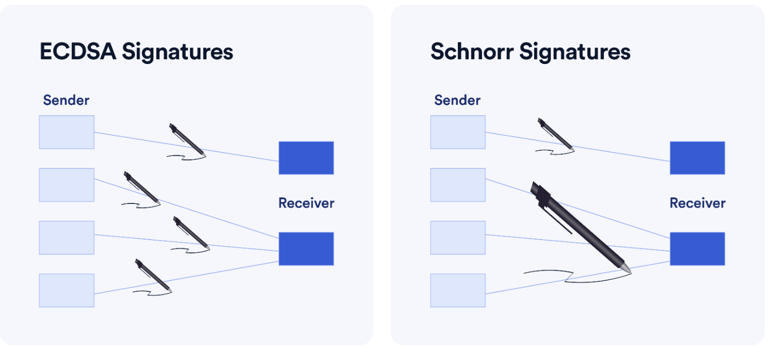Schnorr Signatures for Efficient Bitcoin Transactions
Discover how Schnorr signatures improve Bitcoin transactions and enhance scalability. Learn about the benefits of this innovative technology for faster and more efficient Bitcoin operations.
TECHNICAL
3/26/20252 min read


Importance of digital signatures within cryptography
Digital signatures are the backbone of digital security within the 21st century world. They work by the creation of a public-private key pair which can be used to create digital signatures, which prove a message is authentic without revealing the secret key of the sender. This can be used in numerous applications across the IT field such as secure email and messaging, bitcoin transactions, secure end to end web browsing and many other utilities. Bitcoin utilises ECDSA (elliptical curve digital signature algorithm) as well as the more recently added Schnorr signatures in order to prove ownership of coins as well as transfer them. Schnorr signatures were added in November 2021 within the Taproot upgrade for increased privacy and efficiency, allowing bitcoin to serve its purpose as digital cash a little better
Saving Blockspace with Schnorr
Within the Bitcoin blockchain, UTXOs or unspent transaction outputs are often send to the same output address in a single transaction. Prior to the Taproot upgrade, each of these individual transactions would need to be signed individually, which was not optimised for privacy nor efficiency
For example if Michael has 0.1BTC, 0.2BTC and 0.25BTC as separate UTXOs, and would like to send all of this bitcoin to a receiver, Tom. Traditionally each of the individual UTXOs would need to be signed using ECDSA signatures and each of these signatures permanently published onto the blockchain, whereas with Schnorr, a single aggregated signature encompassing the three inputs provides the required signature and takes up the same amount of block space as a single ECDSA signature, of which previously there were three. This makes transaction size smaller, and therefore increases the capacity of the bitcoin blockchain as well as reducing the cost per transaction
With a single Schnorr signature which combines the individual UTXOs, the source of the bitcoin is more obfuscated which helps add a level of privacy to an open blockchain
History of Schnorr Signatures
Schnorr signatures were proposed by German mathematician and cryptographer Claus-Peter Schnorr in a paper in 1989. Patents made this technology unable to be fully utilised by the world until 2008. Satoshi intentionally implemented ECDSA into Bitcoin, avoiding the more efficient Schnorr Signatures in order to keep bitcoin within the regulatory framework, as the patent expired in 2008, Schnorr signatures could be utilised within Bitcoin without regulatory concern. The Bitcoin core team implemented Schnorr signatures into Bitcoin with a soft fork titled Taproot in 2021, along with other upgrades such as Taproot (The main upgrade) and Tapsrcipt. The soft fork would mean that the old nodes still running the non-updated software were still valid and could run on the bitcoin network validating transactions, hard forks are more divisive and often fragment and weaken the network and thus should not be implemented too often
Future scope
In future bitcoin updates, zk STARKS could be implemented which could hypothetically replace digital signatures in their entirety and validate transactions in larger batches which would significantly increase the transactions per second within the bitcoin network


Get in Touch
We'd love to hear from you! Reach out for questions, feedback or other enquiries
Reach
info@bitesizedblockchain.com
Bite Sized is not affiliated with these brands in any way





Grab your daily web 3 byte
